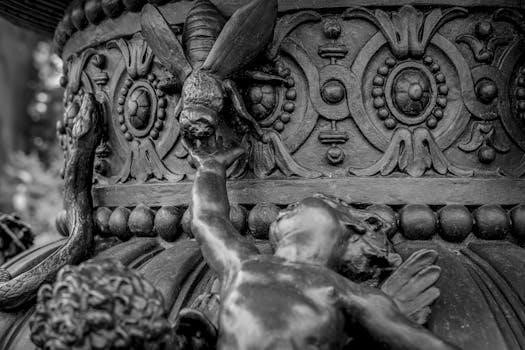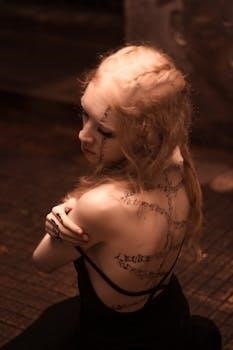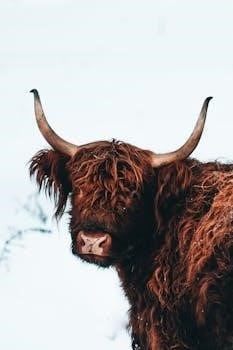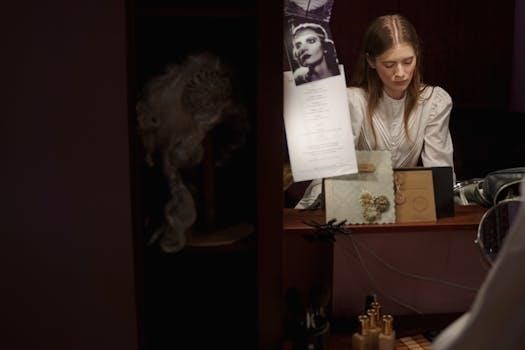
beauty and the beast script pdf
The narrative of Beauty and the Beast has captured hearts across generations, evolving through various script adaptations. These scripts range from the classic fairy tale to stage plays, musicals, and both animated and live-action films. Each version interprets the core story, exploring themes of inner beauty and transformation with unique perspectives.
Overview of the Various Script Versions
The tale of Beauty and the Beast has seen numerous script adaptations, each offering a distinctive take on the classic narrative. These versions range from traditional stage plays, often staying close to the original fairy tale, to elaborate musical theatre productions with original songs and choreography. The animated films, such as Disney’s 1991 version, have established iconic visual and musical interpretations influencing later adaptations. Furthermore, live-action remakes, like the 2017 film, attempt to recreate the magic of the animation with real actors and cutting-edge technology, occasionally introducing new plot elements or character nuances. Beyond theatrical and cinematic scripts, there are also adaptations designed for smaller-scale performances, including children’s plays and school productions, which simplify the story or focus on specific educational themes. Each format brings its own set of challenges and possibilities for storytelling, impacting the characters, themes, and overall message of Beauty and the Beast.
The 1991 Animated Film Script
The 1991 Disney animated film, “Beauty and the Beast,” features a script by Linda Woolverton, which significantly shaped the modern perception of the story. This script introduced iconic elements such as the enchanted household staff and the memorable songs by Alan Menken and Howard Ashman. The narrative structure of the animated film emphasizes Belle’s intelligence and independence, portraying her as a book-loving character who rejects the shallow advances of Gaston. The Beast is depicted as a complex figure, initially angry and selfish, but gradually revealing his vulnerability and capacity for love through his interactions with Belle. The script is notable for its blending of humor, romance, and pathos, effectively appealing to a wide audience. Moreover, the film’s screenplay carefully weaves together multiple plot threads, from the curse on the Beast to Belle’s relationship with her father, creating a cohesive and captivating storyline. The script effectively utilizes the medium of animation to bring the magical world of the fairy tale to life.

Live-Action Adaptation Scripts
Live-action adaptations offer a new lens through which to view the classic tale. These scripts aim to translate the animated charm into a realistic setting, often adding layers of depth to characters and their motivations while staying true to the heart of the original story.
The 2017 Script by Chbosky and Spiliotopoulos
The 2017 live-action adaptation of Beauty and the Beast, penned by Stephen Chbosky and Evan Spiliotopoulos, presents a reimagining of the classic tale. This script builds upon the beloved 1991 animated film, incorporating the original songs by Alan Menken and Tim Rice while expanding the narrative and character development. The script offers a deeper look into the backstory of the Beast, exploring the reasons behind his arrogance and the curse that befell him. It also emphasizes Belle’s intelligence and independence, solidifying her status as a strong female character. This adaptation aimed to bring a level of realism to the fantasy, grounding the characters and their struggles in a relatable context, all while maintaining the magical core of the story. Chbosky and Spiliotopoulos’ script provides a detailed stage direction and narration, enhancing the visual experience of the movie. Their work serves as a bridge between the animated classic and a more contemporary cinematic experience, appealing to both longtime fans and new audiences.
Adaptation of Story, Characters, and Music
The adaptation of “Beauty and the Beast” across various scripts demonstrates significant choices regarding the story, characters, and musical elements; The core narrative of a cursed prince and a compassionate young woman remains consistent, yet each adaptation brings its own nuances. Characters like Belle, the Beast, Gaston, and the enchanted objects are portrayed with varying levels of depth and complexity. Some versions focus more on the Beast’s internal struggles, while others highlight Belle’s intelligence and bravery. The music, a central aspect, sees adaptations that range from faithful recreations of the animated film’s score to fresh interpretations and added musical numbers, enhancing emotional moments and dramatic scenes. These adaptations are carefully crafted to appeal to different audiences, with changes in tone, pacing, and character dynamics to suit various mediums, whether stage play or live-action film, while staying true to the essence of the timeless fairy tale.

Play and Musical Scripts
Stage adaptations of Beauty and the Beast offer varied interpretations, encompassing both plays and musicals. These scripts often emphasize theatrical elements, such as character interactions and stage design, bringing the magical story to life. Musical versions integrate song and dance.
Stage Play Adaptations Based on the Fairy Tale
Numerous stage play adaptations of “Beauty and the Beast” exist, each offering a unique take on the classic fairy tale. These scripts are designed for theatrical performance, often focusing on dialogue, character development, and dramatic staging. Many draw inspiration directly from Charles Perrault’s original story, emphasizing the themes of inner beauty and the transformative power of love. Some adaptations incorporate elements from other versions, such as the Disney animated film, to create a more familiar or modernized version. These plays range in scale, from small productions with a few actors to larger, more elaborate shows with extensive sets and costumes. Character portrayals can vary significantly, with some scripts giving more depth to characters like the Beast or Belle’s family, and some scripts try to add more comedy into the production. Furthermore, many stage play scripts are written to be accessible for all ages, making them perfect for community theaters, schools, or children’s performance groups. The dramatic structure typically follows the fairy tale’s arc, highlighting the initial conflict, the developing relationship between Belle and the Beast, and the final resolution.
Libretto and Musical Elements

The musical adaptations of “Beauty and the Beast” feature a libretto that intertwines spoken dialogue with song lyrics, creating a seamless narrative experience. These librettos are often based on the story of the Disney animated film, incorporating popular songs by Alan Menken and Tim Rice. The musical elements enhance the emotional depth of the story, allowing characters to express their feelings and motivations through song. The structure of the music is designed to support the dramatic action, with upbeat ensemble numbers, tender ballads, and dramatic pieces to help convey the mood. The libretto often includes stage directions, indicating how the music should be performed, along with character interactions, and scene changes, ensuring a cohesive and engaging performance. Musical scores can be adapted for various performance settings, from large orchestras to smaller, intimate ensembles. Furthermore, some musicals include additional songs or variations on the original score to provide a unique perspective to their version. Overall, the libretto and musical elements are crucial for creating a successful production of “Beauty and the Beast,” combining music and dialogue to tell this enchanting story.

Themes and Elements
The scripts of “Beauty and the Beast” commonly explore the transformative power of love, focusing on the shift from outward appearance to inner qualities. They also emphasize the importance of kindness, compassion, and overcoming prejudices through understanding and empathy, as key themes;
The Transformation of the Beast
The transformation of the Beast is a central element across all “Beauty and the Beast” scripts, representing a profound journey from arrogance and selfishness to humility and compassion. Initially portrayed as a spoiled prince, his external transformation into a beast is a physical manifestation of his inner ugliness. This curse serves as a catalyst for him to confront his flaws. The various scripts explore the Beast’s gradual change as he interacts with Beauty, learning to care for someone other than himself. Through her kindness and spirit, he begins to soften, questioning his past behavior. This internal shift is often depicted through his growing vulnerability and his willingness to show empathy. The scripts reveal that his external appearance changes only when he has genuinely transformed on the inside, highlighting the significance of inner beauty. The removal of the curse reflects his complete redemption, emphasizing that true transformation comes from within. The Beast’s journey is a potent reminder that change is possible through love and genuine connection.
The Role of Beauty and Inner Beauty
In “Beauty and the Beast” scripts, the character of Beauty embodies the concept of inner beauty, which is a driving force for positive change. Unlike the superficiality of those around her, Beauty values kindness, intelligence, and empathy above physical appearance. Her initial willingness to sacrifice herself for her father demonstrates her selfless nature. Throughout the story, Beauty’s interactions with the Beast are marked by her ability to look beyond his monstrous exterior and see his potential for good. Her perception of him is not influenced by his appearance but by his actions, highlighting the importance of judging others based on their character. The scripts consistently emphasize that true beauty resides within, and Beauty serves as the catalyst for the Beast’s transformation by helping him to discover his inner self. The narrative underscores the idea that outward beauty is fleeting, while inner beauty has the power to inspire and heal.
Copyright and Licensing Information
When working with “Beauty and the Beast” scripts, it is crucial to understand the copyright and licensing implications. Different versions of the script, whether they are for stage plays, musicals, or film adaptations, are protected under copyright laws. This means that any performance or public reading of the script requires obtaining proper licensing from the copyright holders. Typically, these rights are managed by licensing agencies. For example, Disney’s “Beauty and the Beast” musical versions are licensed through specific theatrical licensing companies. Unauthorized use, including performances without the necessary permissions, can lead to legal repercussions. Furthermore, any modifications or alterations to a copyrighted script may also require explicit consent from the copyright owner. It is also important to check if the script you are using is the official version authorized by the license holder. Many unofficial versions are available online, but they lack legal permission for performance. Always ensure that you are using legally obtained and licensed scripts to avoid copyright infringement.